OK, so I thought I'd give it a shot and implement this with some vector math, it's prettier and the result is reusable.
A few clarifications:
- A "vector" is simply two numbers (x and y)
- "Coordinates" are in structure identical to vectors, they just mean something different to us. We can run the same math on the though.
- A "positioned vector" is two vectors (like source and destination)
- You can "free" a positioned vector by subtracting the first vector from the second one (you get a new vector which is no longer anchored in the coordinate system)
- The "length" of a vector is calculated using pythagoras theorem (also called norm)
- "Vector addition" is simply adding the the xs and ys of two or more vectors, resulting in a new vector.
- "Scalar multiplication" and division is done by dividing x and y with the scalar
- A "unit vector" is the vector divided by its length
Assuming we want this to to work dynamically ("per tick"), the initial links adjustment looks like this (I am using coffeescript):
links.attr('x1', ({source,target}) -> source.x)
.attr('y1', ({source,target}) -> source.y)
.attr('x2', ({source,target}) -> target.x)
.attr('y2', ({source,target}) -> target.y)
What we want to do is move the source and target nodeRadius away from the circle. For that we use vector math to
- free the positioned vector (the link consists of two coordinates, we want a single unanchored vector)
- calculate the unit vector of the free vector
- once we have that, we can multiply it by
nodeRadius. This new vector represents the distance between the node center and its border, with the same direction as the link.
- add the vector to the source coordinates, these new coordinates will be on the edge of the circle.
OK, so we will use the following functions to do this:
length = ({x,y}) -> Math.sqrt(x*x + y*y)
sum = ({x:x1,y:y1}, {x:x2,y:y2}) -> {x:x1+x2, y:y1+y2}
diff = ({x:x1,y:y1}, {x:x2,y:y2}) -> {x:x1-x2, y:y1-y2}
prod = ({x,y}, scalar) -> {x:x*scalar, y:y*scalar}
div = ({x,y}, scalar) -> {x:x/scalar, y:y/scalar}
unit = (vector) -> div(vector, length(vector))
scale = (vector, scalar) -> prod(unit(vector), scalar)
free = ([coord1, coord2]) -> diff(coord2, coord1)
This might look a little overwhelming, it's very compact because coffeescript allows us to deconstruct things directly in the method signature, quite handy!
As you can see there is another function called scale. It's simply a convenience function to combine steps 2. & 3.
Now let's try and set the new x coordinate for the link source. Remember: The coordinate should be moved by nodeRadius, so that it starts on the border of the circle instead of inside it.
(d) ->
# Step 1
freed = free(d)
# Step 2
unit = unit(freed)
# Step 3
scaled = prod(unit, nodeRadius)
# Step 2+3 would be scale(freed, nodeRadius)
# Step 4, coords are pretty much just vectors,
# so we just use the sum() function to move the source coords
coords = sum(d.source, scaled)
return coords.x
Nothing to it! Putting all of that into the tick() function, we get:
links.attr('x1', ({source,target}) -> sum(source, scale(free([source,target]), nodeRadius)).x)
.attr('y1', ({source,target}) -> sum(source, scale(free([source,target]), nodeRadius)).y)
.attr('x2', ({source,target}) -> diff(target, scale(free([source,target]), nodeRadius)).x)
.attr('y2', ({source,target}) -> diff(target, scale(free([source,target]), nodeRadius)).y)
Oh, and don't forget to subtract from the target coordinates, otherwise you'd just be making the line longer again (i.e. moving it by nodeRadius).

